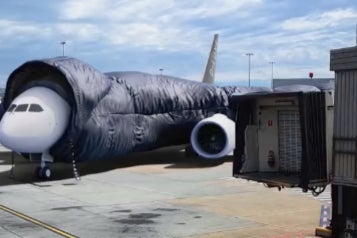The Independent's journalism is supported by our readers. When you purchase through links on our site, we may earn commission.
No, planes in Alaska aren’t wearing jackets despite what the internet thinks
People were fooled after the puffer jacket plane went viral

A “cute” clip of an aircraft has convinced the internet that planes in Alaska wear coats in the cold to “protect from extreme temperatures” – but is it real?
Fans of the puffer jacket plane, prepare to be disappointed.
The bundled-up Boeing is, in fact, an AI-generated promotional video from Australian brand Decjuba. It has amassed 18.9 million views on TikTok since it was first posted on 3 April.
The marketing video has since been reshared by several pages on social media with the caption: “Custom jackets, also known as engine covers or aircraft covers, are designed to protect planes from extreme cold temperatures in Alaskan airports, often reaching -60°C (-80°F) or lower.”
According to the fake posts, the custom cabin jackets play a “vital role in protecting aircraft from Alaska’s extreme cold, ensuring safe and efficient operations”.
“These jackets prevent engine and electronics damage, reduce risk of fuel freezing, minimize corrosion, and maintain aircraft systems’ functionality,” claimed a post by Explaining Everythings on Instagram.
Simon Calder, travel correspondent for The Independent, called the jet jackets “extremely implausible” and said: “Aircraft, unlike humans, don’t need any special clothing to cope with ultra-low temperatures. They routinely fly at 40,000 feet where the outside air temperature is typically –50C to –60C. They can handle the cold down to about –75C without an issue.”
According to Air Canada, aircraft are “built for cold temperatures”, with temperatures at cruising altitude often around -57C.
“Aviators welcome the denser air that comes with extreme cold,” said the airline’s enRoute magazine, as “cold air produces more lift over the wings and flight controls, and more thrust from the engines and propellers”.
However, extreme cold can cause problems for planes while they are on the ground.
The Federal Aviation Administration (FAA) said in a “Winter Flying” notice for Alaska: “In preparing the aircraft for flight, warm-up procedures are a necessity in Alaska’s very cold temperatures. Using a hangar is best, as it is comfortable and time efficient.”
Pilots should “dress warmly”, warm the engine before starting and carry a survival kit as required by Alaska law, advise the FAA.
For more travel news and advice, listen to Simon Calder’s podcast
Join our commenting forum
Join thought-provoking conversations, follow other Independent readers and see their replies
Comments